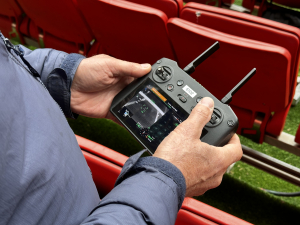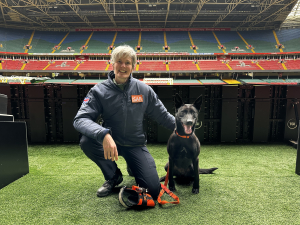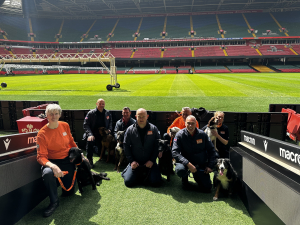UK Search and Rescue Teams gather for training exercises in South Wales
Last week, members of the UK’s domestic and international search and rescue teams came together to carry out highly specialised training in Wales’s capital city.
Urban Search and Rescue (USAR) and International Search and Rescue (ISAR) teams are typically deployed in the wake of events such as natural disasters or acts of terrorism, and are responsible for finding and freeing trapped people.
From Monday 22nd April to Wednesday 24th, teams from across the UK rallied in Cardiff and Gloucester for training exercises, travelling from fire service bases in Essex, Kent, Hampshire, Lancashire, Lincolnshire, Merseyside, West Midlands, Scotland, South Wales, and Mid and West Wales.
Utilising both the Heath hospital and the Principality Stadium in Cardiff, the teams conducted dog and drone exercises as part of routine training which is vital in aiding their search and rescue efforts. With the assistance of eight highly specialised sniffer dogs and state of the art drone equipment, the team practiced their urban search and rescue training across three days.

Kevin Dite, Watch Manager at South Wales Fire and Rescue Service, and USAR/ ISAR team member, said:
“Different drones are deployed for different reasons. The cameras are useful for open area searching, and some have thermal imaging capabilities, stability systems, and of course they can cover large areas much faster than we can.
“We tend to do this training quarterly, at a minimum. The dogs need to be kept intact and protected, and of course, drone work has a massive skill fade as it’s such intricate flying, so we try and do it as regularly as we can. It’s also about getting the dogs used to the drones; with the low-level humming in the background something that will be constant for them in their rescues.”
In the event of a large-scale disaster, it is safer to send small drones into buildings, followed by the dogs with their acute sense of smell, to search for missing people. The dogs are trained to ‘alert’ to a live person by barking until their handler arrives and rewards them with a favourite toy.
Once the search team pinpoints a lost person, they have a range of tools at hand to make an area safe and to free trapped people. Every rescue is different, but might including shoring up fallen masonry, cutting through debris to help someone to safety, or using heavy lifting equipment to create exit routes.
Last year, some members of these teams were deployed to Malawi, Morocco, and Turkey after national disasters struck the areas – with the drones, the dogs, and their handlers in situ.
Tristan Bowen, USAR team leader and ISAR team member, said:
“The dogs are useful because they will do the job of 20 technicians in half the time. They can collapse themselves into the smallest spaces and have been trained to search for live bodies in destitute areas, using their remarkable scent to detect human life, and can pick up on sweat, carbon dioxide, aftershave or perfume, etc.
“Part of this training involves exposing our operatives to the different scenarios they may come across; be it cold weather survival, hot places, urban areas, city centres, or large-scale venues. We will all be familiar with the explosion which occurred at the Manchester Arena after the Ariana Grande concert in 2017, so the idea is to expose our dogs in the event of deploying into any kind of structure which could pose issues to them in terms of the number of people, the actual scale and size of the building, and all the hidden voids within the building.
“We get deployed internationally quite regularly. I’ve been to Turkey, Nepal, Haiti, and Christchurch New Zealand to assist international relief efforts. As you can imagine, it’s no small feat to ship us all out – we’re classed as a heavy rescue team with all our equipment; including technicians, doctors, vets, dog handlers, structural engineers – the team is huge.
Crew Manager Niamh Darcy and her dog, Vesper, a four-year-old Belgian Malinois, are both members of the USAR and ISAR teams. Vesper works as a search and rescue dog as part of Merseyside Fire and Rescue Service (MFRS), and has been deployed to numerous disasters, most recently the 2023 earthquakes in Turkey and Morocco. Alongside her handler, she has been responsible for locating multiple live casualties and reuniting them with their families.

Vesper also won the Crufts Hero Dog Award 2024 this year, within the category of ‘Extraordinary Life of a Working Dog’ – a category which was open to fire services, the police, and the army.
Niamh said:
“Vesper can clear a building by herself and can indicate to me if there is no need for us to enter a building. These dogs do an awful lot of agility training; you really need a dog that’s meticulous in this kind of role, they run over rubble piles and zone in on a hit, and once the canines have done their job then we commit and zone in on an area to break or breach or lift things off people.
“Malis in general are a very bright breed. They have a very high mental capacity, are very agile, and Vesper in particular is extremely friendly and sociable. However, even if the dogs are proficient in searching, they still need that exposure to travel with you, and they need stamina. We can go for up to 14-hour days when we’re deployed, and she’s very adaptable in that sense.”
